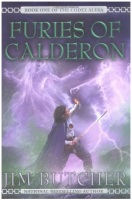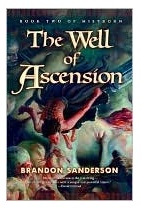 I’m almost embarrassed to admit that my first Jim Butcher novel is not a Dresden Files book, but The Furies of Calderon, the first in his epic fantasy Codex Alera series. Not that there’s anything wrong with that, but when you think Jim Butcher, you think Harry Dresden. So why start with Codex Alera?
I’m almost embarrassed to admit that my first Jim Butcher novel is not a Dresden Files book, but The Furies of Calderon, the first in his epic fantasy Codex Alera series. Not that there’s anything wrong with that, but when you think Jim Butcher, you think Harry Dresden. So why start with Codex Alera?
Because I’m writing a Roman-themed sci-fi book and I was looking to do some shameless stealing. But that aside, I was also in the mood for a page-turning fantasy, and this one did not disappoint.
In The Furies of Calderon, the nation of Alera has a distinct Roman feel – its armies are organized into “legions,” its nobles have Latin names like Quintus and Atticus. But in this world, people can bond with the living furies of earth, fire, water, and metal, giving them magical abilities that keep the nation safe from the monsters and barbarians along Alera’s borders.
When a spy named Amara discovers a plot against Alera’s First Lord Quintus Sextus, she is ordered to the remote Calderon Valley to find out what the traitors are up to. She meets a 15-year-old boy named Tavi who does not have a fury, an odd occurrence among Alerans. Â Amara and Tavi learn that traitorous lords within Alera are working with the monstrous barbarians to bring down the old and weak First Lord Sextus. It is up to Amara and Tavi to stop the coming invasion and bring proof to the First Lord of the conspiracy in his own court.
While the Roman elements weren’t as extensive as I hoped, the book overall was a very good read. The writing was entertaining and fast-paced, making the book feel much shorter than its 500+ pages. The final battle was a bit predictable, but satisfying nonetheless.
Most of the characters were finely drawn – Amara, the young spy with something to prove; Fidelias, the villain you could almost agree with. Unfortunately, the only character I couldn’t warm up to was the protagonist Tavi. He was certainly heroic and likeable, but in a way I’d seen before in many other epic fantasies.
Descriptions of the magic system seemed a little thin. I would’ve liked more information on how it worked, and how the furies feel about being bonded to humans. I assume Butcher saved that for later books, along with answers to many other questions.
Despite some nitpicks, The Furies of Calderon was the fun epic fantasy I was looking for, and a promising start to the Codex Alera.

